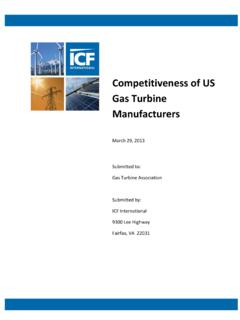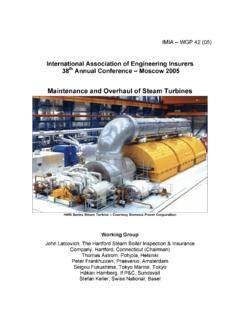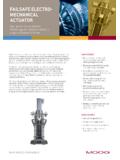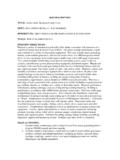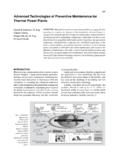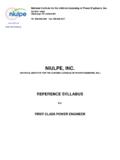Transcription of Comments on Prevention of Significant …
1 26 Aug 2004 Board of Directors Frank Bevc, Chairman Siemens Westinghouse Power Kathryn Rominger, Vice Chair GE Power Systems Robert Mack, Treasurer IR Energy Systems Richard Tuthill, Secretary United Technologies Corporation Mark Self ALSTOM Power Inc Kevin Dugan Capstone turbine John March Rolls-Royce Richard Brent Solar Turbines Air Docket United States Environmental Protection Agency Mail Code: 6102T Room: B108 1200 Pennsylvania Ave. NW Washington DC 20460 Attention: Docket ID No. OAR- 2002-0068 (Legacy Docket ID No. A-2002-04) Re: Comments on Prevention of Significant Deterioration (PSD) and Non-Attainment New Source Review (NSR): Equipment Replacement Provision of the Routine maintenance , Repair and Replacement Exclusion; Reconsideration; Final Rule, 69 Fed. Reg. 40278 (July 1, 2004) Dear Sir or Madam: EPA has requested input on reconsideration of three issues related to the Equipment Replacement Provision (ERP) promulgated on October 27, 2003.
2 The ERP provision clarified when certain equipment replacements are excluded from the New Source Review (NSR) program, under the routine maintenance , repair and replacement (RMRR) exclusion provisions. Member Companies ALSTOM Power Inc. Capstone turbine Corporation Elliott Energy Systems GE Power Systems IR Energy Systems Rolls-Royce Siemens Westinghouse Power Corporation Solar Turbines South Carolina Institute for Energy Studies United Technologies Corporation The three issues EPA has requested input on include: 1. The basis for determining that the ERP was allowed under the Clean Air Act 2. The basis for selecting the cost threshold (20 percent of the replacement cost of the process) that was used in the final rule to determine if a replacement was routine; and 3. A simplified procedure for incorporating a Federal Implementation Plan into state plans to accommodate changes to the New Source Review Rules The Gas turbine Association appreciates the opportunity to comment on the provisions.
3 The Gas turbine Association is an association of gas turbine equipment manufacturers whose role is to represent the gas turbine industry, and to provide relevant technical information needed for policy development. We believe that the basis for selecting the 20% cost threshold was proper and are concerned that lower thresholds would discourage important routine maintenance and replacement activities for a number of our sources across the country. Deferred or undone maintenance and replacement practices could negatively impact unit safety and also result in lower efficiency operation, thereby increasing emissions. Turbines are owned by many commercial, industrial, and utility enterprises. These turbines are used for a variety of purposes such as power generation, gas pipeline compression, liquids pumping, and chemical process operations. They are manufactured in sizes that range from 1 MWe to power blocs larger than 250 MWe. Box 1408, Great Falls, Virginia 22066 202-669-7575 phone 703-757-8274 fax As highlighted in EPA s document: Standards Support and Environmental Impact Statement Volume 1: Proposed Standards of Performance for Stationary Gas Turbines EPA-450/2-77-017, September 1977, Chapter 5, Modification and Reconstruction, turbines require ongoing maintenance , repair and replacement.
4 As stated in the above referenced document, EPA has concluded that these activities are routine and thus excluded from the NSPS modification and reconstruction provisions. Some excerpts from this EPA document are below: Modifications paragraph (e) lists certain physical or operational changes which will not be considered as modifications, irrespective of any change in the emissions rate. These changes include: 1 Routine maintenance , repair and Reconstruction Section states: If an owner or operator of an existing facility proposes to replace components, and the fixed capital cost of the new components exceeds 50 percent of the fixed capital cost that would be required to construct a comparable entirely new facility, he shall notify the Administrator of the proposed replacements. The notice must be postmarked 60 days (or as soon as practicable) before construction of the replacements is Applicability to Gas turbine Installations General: Most turbines are designed for 20,000 to 40,000 operating hours between overhauls.
5 Modification The following physical or operational changes will not be considered as modifications to existing turbines: a. Changes determined to be routine maintenance , repair, or replacement in kind. This will include repair or replacement of stator blades, turbine nozzles, turbine buckets, fuel nozzles, combustion chambers, seals and shaft packings.. The impact of the modification provision on existing gas turbines should be very slight. Reconstruction It is difficult to apply the definition of reconstruction to a gas turbine because substantial portions of a turbine may be replaced as a matter of routine maintenance during normal overhauls as described in Since it is current practice to replace substantial portions of turbines, it would be difficult to discriminate between a major overhaul that was performed to avoid the purchase of a new turbine and one that was performed in accordance with a routine maintenance program. Such routine maintenance should be exempted from the regulatory consequences of becoming a reconstructed turbine , subject to the 50 percent rule , discussed in (emphasis added) It is clear that from the NSPS document cited above that major overhauls, or major disassembly inspections on turbines occur routinely and that EPA clearly considered them to be exempt from New Source Performance Standards under the routine maintenance , repair and replacement exclusion provisions.
6 Further, EPA states that routine maintenance should also be exempt from EPA s reconstruction provisions. Importantly, since the NSR term modification came from the NSPS definition and since the NSR program, like the NSPS program, exempts routine maintenance , repair and replacement activities from NSR, most agencies have appropriately considered major overhauls and other turbine maintenance to be routine, maintenance , repair and replacement for purposes of both NSPS and NSR. Indeed, if these operations were not exempt from NSPS and NSR, many critical industrial operations would be severely impacted, operating at reduced efficiency, while the operators stretch-out their maintenance intervals as long as possible. More likely, if normal gas turbine overhauls were not exempt from these provisions, neither turbines nor valuable cogeneration installations would have been installed in the first place, since the economic recovery period for such an installation is usually longer than 2 to 3 years.
7 At any rate, overhaul maintenance activities are common, clearly required and have been recognized to be routine in the past. Gas turbine manufacturers also recognize this, and typically specify a series of scheduled maintenance intervals. The shortest is usually being 8,000 hours. Manufacturers will specify the inspection and repair intervals based on a unique set of criteria that are appropriate for each type of engine. It is usually at the longest interval, somewhere between 30,000 and 50,000 hours where overhaul costs are the most Significant . The expense for the maintenance overhaul will be influenced by the severity of the service, fuel type used, location, union vs. non-union personnel, and initial design features of the turbine (the use of high temperature alloys and ceramics which are costly, for example). Box 1408, Great Falls, Virginia 22066 202-669-7575 phone 703-757-8274 fax Premature failures, which are unpredictable, can also significantly shorten the inspection/overhaul interval.
8 When this occurs, to minimize future downtime and expense, a complete overhaul is generally performed on the gas turbine , with inspections on equipment impacted by any of the potential turbine failure modes (such as the generator or the steam cycle). In some cases a gas turbine will be used in a highly critical process application, where immediate redundancy is not available. A gas turbine failure in such an application can have severe consequences to the owner and potentially to the OEM. One solution is for the manufacturer (or the package supplier) to make available a temporary replacement unit from a lease pool for the owner to use while the original unit is repaired. Other manufacturers simply swap out the bad unit for functionally equivalent good unit allowing the bad unit to be fixed and ready for use when another unit It should be noted that to minimize the expense of the maintenance and maximize the quality of repairs by providing well qualified personnel to inspect and maintain the turbines, most overhauls are done off-site at the manufacturer s recommended shop.
9 When considering the overhaul cost as a percentage of the initial investment costs, the figures can vary widely, because gas turbines are used in so many different applications. For a simple cycle gas turbine , the overhaul costs can exceed 20% of the initial investment. For a combined cycle power plant, those costs drop rapidly (as a percentage) because of the very large investment in auxiliary equipment that is not usually part of the regular gas turbine overhaul (the steam turbine , heat recovery steam generator, and power switchyard, for example). In such a case, the overhaul costs can drop to 10% or less of the initial investment. In any case, overhaul maintenance operations have clearly been considered to be routine maintenance for turbines under NSPS and in most cases under NSR provisions. Yet, depending on the size of the unit and the complexity of the routine maintenance or replacement required, the repair/replacement costs as a percentage of the installed process unit cost is typically higher than the repair/replacement cost ratios for some other types of industrial equipment.
10 Below, we provide some data on costs for turbine maintenance as a percent of total equipment costs. maintenance costs, as a percentage of the Equipment Replacement Value Gas turbine Overhaul and maintenance As noted in EPA s NSPS document cited above, gas turbine overhauls are routinely performed. Manufacturers specify the maintenance and overhaul schedules for each turbine model. To obtain data on overhaul cost, as a percentage of the equipment replacement value, the Gas turbine Association requested Southwest Research Institutesummarize typical, industry-wide, overhaul costs as a percentage of the direct equipment replacement costs for units between 1 and 25 MW. GTA also requested that SwRI estimate the total installed equipment replacement value of the process unit, so we could compare these costs to EPA s 20% equipment replacement value exclusion. SwRI developed a set of budgetary installation factors from historical data which, when multiplied by the direct equipment cost, could be used to approximate the installed cost of the process unit, or the equipment replacement value of the process unit.
